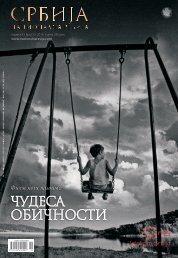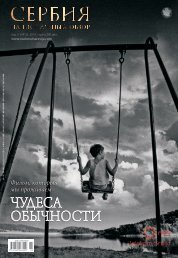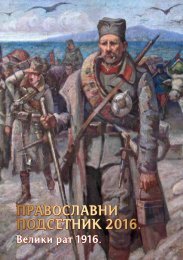Zajecar - engleski - niska rezolucija
You also want an ePaper? Increase the reach of your titles
YUMPU automatically turns print PDFs into web optimized ePapers that Google loves.
ZAJEČAR − CAPITAL OF SERBIAN EAST<br />
60<br />
because of a small number of students the school was closed<br />
in 1905. With the help of the Ministry of Trade of Serbia and<br />
Belgrade Youth Trade Organization, Artisan-Trading School<br />
was opened in Zaječar on November 7, 1910. It worked until<br />
the end of World War One, and then it grew into two threeyear<br />
long schools: Trading and Artisan. Pursuant to the decision<br />
of Moravska District, in 1934 the Artisan School became<br />
Vocational School for the Learning of Crafts. In 1921, a fourgrade<br />
Trading School was opened in Zaječar, and College of<br />
Trading also worked for some time, and it is especially interesting<br />
that there was Art School in Zaječar from 1923 to 1929.<br />
In 1839, Za je čar gymnasium was moved to Ne go tin, where<br />
the Bishop of Timok also moved that same year. In 1844,<br />
in Ne go ti n it was, pursuant to the Law on Gymnasiums,<br />
turned into a four-grade semi-gymnasium. Renowned people<br />
from Zaječar managed to persuade Duke Mi lo š to return<br />
the gymnasium to Za je čar in 1860, but in 1866 it was moved<br />
to Ne go tin again. Za je čar responded to this decision by establishing<br />
a two-grade real school (1869), which was given<br />
the third grade 10 years later, and the fourth grade in 1880,<br />
when it became junior high school. A year later, the gymnasium<br />
was given its own reading room. For eight years, literary<br />
group “Na pre dak” was active with the Reading room,<br />
around which Zaječar youth gathered.<br />
Resourceful Za je čar MP’s at the Assembly skillfully used<br />
the then applicable assembly procedure and pushed their<br />
request for opening the full gymnasium before the Negotin’s<br />
request, which had been submitted earlier. This caused<br />
great animosity of their neighbors, but Za je čar received a<br />
full seven-grade gymnasium which, as of 1891/92 academic<br />
year, became eight-grade gymnasium. That is how the Zaje<br />
čar gymnasium became one of the five full gymnasiums<br />
in Serbia (The First and Second Belgrade Gymnasium, and<br />
gymnasiums in Kragujevac, Niš and Zaječar).<br />
Accounts say that on St. Jeremiah Day in 1891, on May<br />
1 according to the old calendar, when the Day of the liberation<br />
of the city was celebrated, a foundation stone for the<br />
construction of gymnasium was officially laid in Zaječar. For<br />
Za je čar at that time it was a great celebration. In accordance<br />
with customs, a sealed bottle with inscription and signatures<br />
of state officials, with whose support the construction of the<br />
building had started, as well as with signatures of Mi ha i lo<br />
Bo bi ć, who was the director at that time, was embedded in<br />
the foundations, and municipality president Ili ja Bo ško vi ć.<br />
1<br />
Cover page of<br />
“Spo me ni ca”<br />
of Zaječar<br />
Gymnasium,<br />
published for<br />
100 th anniversary<br />
of the school<br />
Almanac<br />
Professor Mi lan<br />
Cve ti ča nin, longtime<br />
principal of Zaječar<br />
Grammar School,<br />
for the prominent<br />
school’s centenary in<br />
1936, wrote a Commemorative<br />
which<br />
is an important<br />
historical resource<br />
even today. The<br />
old professor also<br />
testifies about the<br />
existence of almanac<br />
Za je ča rac, probably<br />
the oldest book<br />
printed in Zaječar.<br />
Besides the almanac,<br />
it contained, he said,<br />
“the information on<br />
fairs, old and new<br />
units of measure, as<br />
well as anecdotes,<br />
witticisms and funny<br />
stories.” There have<br />
been indications<br />
that the book was<br />
printed in 1884 in the<br />
printing house owned<br />
by Mi li sa v Ni ko li ć<br />
Ja go din ac, but, unfortunately,<br />
Zaječar<br />
archives and libraries<br />
have not preserved a<br />
single copy of<br />
that edition.

















